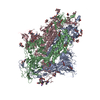+Search query
-Structure paper
| Title | C-2 Thiophenyl Tryptophan Trimers Inhibit Cellular Entry of SARS-CoV-2 through Interaction with the Viral Spike (S) Protein. |
|---|---|
| Journal, issue, pages | J Med Chem, Vol. 66, Issue 15, Page 10432-10457, Year 2023 |
| Publish date | Aug 10, 2023 |
 Authors Authors | Marta Gargantilla / Clara Francés / Anmol Adhav / Alicia Forcada-Nadal / Belén Martínez-Gualda / Olaia Martí-Marí / María Luisa López-Redondo / Roberto Melero / Clara Marco-Marín / Nadine Gougeard / Carolina Espinosa / Antonio Rubio-Del-Campo / Rafael Ruiz-Partida / María Del Pilar Hernández-Sierra / Laura Villamayor-Belinchón / Jerónimo Bravo / José-Luis Llacer / Alberto Marina / Vicente Rubio / Ana San-Félix / Ron Geller / María-Jesús Pérez-Pérez /  |
| PubMed Abstract | Severe acute respiratory syndrome coronavirus 2 (SARS-CoV-2) causes COVID-19, by infecting cells via the interaction of its spike protein (S) with the primary cell receptor angiotensin-converting ...Severe acute respiratory syndrome coronavirus 2 (SARS-CoV-2) causes COVID-19, by infecting cells via the interaction of its spike protein (S) with the primary cell receptor angiotensin-converting enzyme (ACE2). To search for inhibitors of this key step in viral infection, we screened an in-house library of multivalent tryptophan derivatives. Using VSV-S pseudoparticles, we identified compound as a potent entry inhibitor lacking cellular toxicity. Chemical optimization of rendered compounds and , which also potently inhibited genuine SARS-CoV-2 cell entry. Thermofluor and microscale thermophoresis studies revealed their binding to S and to its isolated receptor binding domain (RBD), interfering with the interaction with ACE2. High-resolution cryoelectron microscopy structure of S, free or bound to , shed light on cell entry inhibition mechanisms by these compounds. Overall, this work identifies and characterizes a new class of SARS-CoV-2 entry inhibitors with clear potential for preventing and/or fighting COVID-19. |
 External links External links |  J Med Chem / J Med Chem /  PubMed:37471688 / PubMed:37471688 /  PubMed Central PubMed Central |
| Methods | EM (single particle) |
| Resolution | 3.4 - 4.3 Å |
| Structure data | EMDB-17576, PDB-8p99: EMDB-17578, PDB-8p9y: |
| Chemicals |  ChemComp-NAG:  ChemComp-NA:  ChemComp-XIO: |
| Source |
|
 Keywords Keywords |  VIRAL PROTEIN / Spike / VIRAL PROTEIN / Spike /  SARS COV-2 / Inhibitor SARS COV-2 / Inhibitor |
 Movie
Movie Controller
Controller Structure viewers
Structure viewers About Yorodumi Papers
About Yorodumi Papers








